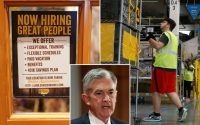Janet Yellen is selling bank crisis short as execs fear dozens more teeter on brink
Listening to Janet Yellen, you might be led to believe that the US banking system is, in her words, “sound,” and that your deposits “remain safe.”
She’s the Treasury secretary, after all. She must have some clue, right?
Nope. Top financial CEOs tell me she’s mostly MIA as our banking system shows serious signs of cratering. In her two years as the government’s top banker, Yellen has failed to grasp the full magnitude of the problem because she has instead been too focused on other stuff like Ukraine, abortion, and all those progressive causes she’s championed.
The problem is pretty obvious if you can read a balance sheet. Top financial executives have privately identified as many as 25 regional and mid-sized banks in the neighborhood of $15 billion to $200 billion in assets that are ripe for failure. The ill-fated Silicon Valley, Signature banks, and today’s latest headache, First Republic, are the festering sores that signal an even greater degree of banking rot.
On one hand, 25 mid-sized bank debacles sounds better than the vast 2008 financial collapse that began with Lehman Brothers bankruptcy and spread to our biggest banks and Wall Street firms.
It also sounds better than the scare number recently circulating – that nearly 200 banks are in danger of imploding. But not so much when you start adding up the assets and deposits that might be lost by the so-called “dirty two-dozen.”

Look up any list of the biggest banks by assets, minus the top five or so, and we’re talking trillions in assets that could be wiped out even if the big banks remain solid.
When the first 25 go south, that’s when the rest of the system is in danger of a wider collapse, making the scare number imminently possible. It also ratchets up the chances of a deep recession.
Follow The Post’s coverage of Silicon Valley Bank’s collapse
Again, you won’t hear any of this from Yellen or Sleepy Joe Biden — they’re too busy doing their best imitation of Kevin Bacon’s clueless security guard character in “National Lampoon’s Animal House,” shouting “Remain calm, all is well!” before being trampled by a hysterical mob.
The bankers I speak to aren’t sugarcoating anything and they are starting to panic. They’re looking at balance sheets, and throughout much of regional banking, they see the risky loans, the asset-liability mismatches that doomed SBV, Signature, and possibly First Republic.

They’re likening it to the thrift crisis of the late 1980s early 1990s, maybe not in scale (more than 1,000 so-called savings and loans went belly-up) but certainly in size given the greater concentration of bank assets today in fewer institutions.
Recall that with the thrift crisis came a recession. The irrational exuberance that led so many average people to lose money in meme stocks and crypto has now reached the once staid regional and community banking system. It was spurred by interest rate hikes to calm inflation that was hitting the middle class and its ability to afford food and gas.

Even if the Fed pauses in its rate hikes this week, those already in place are squeezing asset values and bank balance sheets leaving the most vulnerable – that 25 in number according to the people I speak to – facing a decent chance of collapse.
Top CEOs are working to stop it. The market bounced back Monday after the merger-bailout of Credit Suisse, but shares of First Republic continued to slide sharply. As I was first to report, on these pages and for Fox Business, First Republic, with JPM as its banker, is shopping itself before it too collapses.
Jamie Dimon, the CEO of JPMorgan, is personally working the phones to get the deal done and slowdown the contagion. He believes the banking tumult is that signal that his famous the economic “storm” prediction unfortunately is now coming our way.
But the history of financial contagions shows such one-offs never work. Dimon’s bank and others last week pumped $30 billion of deposits into First Republic to stabilize it, and its shares continued to tank. Before the fateful Lehman Moment back in ’08, there were capital infusions of bond insurers; Bear Stearns’ forced merger with Dimon’s JPM; mortgage giants Fannie Mae and Freddie Mac being placed into government conservatorship, and I’m sure I missed a few.
What is needed is leadership from Washington, and a recognition we have a problem that requires a broader solution. This, unfortunately, is stuff that Yellen and Sleepy Joe can’t seem to comprehend.


